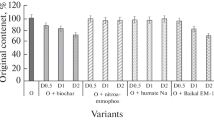Abstract
Drilling fluids are used for drilling natural gas, oil and water wells. These spill over into the surrounding soil at the point of drilling, which may impair soil health. A laboratory investigation was carried out to determine the effect of non aqueous drilling fluid (NADF) and synthetic base oil used with it on soil health as indicated by the dehydrogenase activity. A non-sterile sandy loam soil was treated with different amounts of NADF and base oil at a rate of 800, 8,000 and 16,000 mg kg−1. Initially, reduction in dehydrogenase activity was observed, but it increased with the incubation time. On the 60th day of incubation dehydrogenase activity in untreated control was 1.04 mg TPF g−1 h−1 whereas in the soil samples treated with NADF and the base oil (16,000 mg kg−1), the activity was 1.53 mg TPF h−1 and 1.90 mg TPF h−1, respectively, which was 72 and 82% more than in untreated control. Base oil-treated soil showed more dehydrogenase activity than that observed with NADF. Both NADF and base oil stimulated the soil dehydrogenase activity.

Similar content being viewed by others
References
Black CA, Evans DD, Ensminger LE, White JJ, Clark FE (1965) Methods of soil analysis. American Society of Agronomy Inc, Publisher
Casida LE, Klein DA, Santoro T (1964) Soil dehydrogenase activity. Soil Sci 98:371–376
Deng SP, Parham JA, Hattey JA, Babu D (2006) Animal manure and anhydrous ammonia amendment alter microbial carbon use efficiency, microbial biomass, and activities of dehydrogenase and amidohydrolases in semiarid agroecosystems. Appl Soil Ecol 33:258–268
IAOGP (2003) Report on environmental aspects of the use and disposal of non-aqueous drilling fluids associated with offshore oil and gas operations by International Association of Oil and Gas Producers
Ladd JN, Paul EA (1973) Changes in enzymatic activity and distribution of acid soluble, amino acids nitrogen in soil during nitrogen immobilization and mineralization. Soil Biol Biochem 5:825–840
Lee KE (1994) The functional significance of biodiversity in soils. 15th World Congress of Soil Science, Acapulco, Mexico, vol 4A, pp 168–182
MoEF (2003) Ministry of Environment and Forests (MoEF) Notification G.S.R.546 (E) New Delhi, 30th August, 2005
Milošević NA, Govedarica MM (2002) Effect of herbicides on microbiological properties of soil. Proc Nat Sci 102:5–21
Acknowledgments
The authors acknowledge Total Petroleum India Ltd., for providing the drilling mud and base oil for analysis.
Author information
Authors and Affiliations
Corresponding author
Rights and permissions
About this article
Cite this article
Wakadikar, K., Sil, A., Kolekar, N. et al. Effect of non-aqueous drilling fluid and its synthetic base oil on soil health as indicated by its dehydrogenase activity. Environ Earth Sci 64, 25–28 (2011). https://doi.org/10.1007/s12665-010-0812-z
Received:
Accepted:
Published:
Issue Date:
DOI: https://doi.org/10.1007/s12665-010-0812-z




